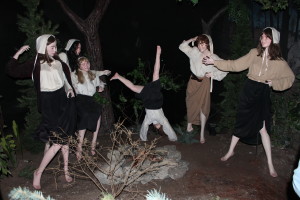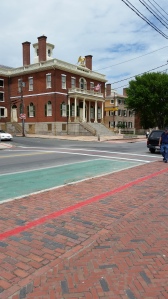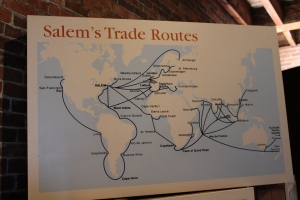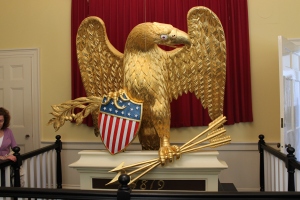I am very excited and happy to announce I have selected a new audio book narrator for “Cradle to Grave” and “Death in Salem”. As any librarian will tell you, audiobooks are very very popular. A good narrator can really make a story shine. I am very glad to see both these titles become audiobooks for all my patrons.
Category Archives: Salem
Witch Hunts after Salem
Although the witch craze in Salem ended, with many consequences as I have mentioned in an earlier post, the belief in witches did not end. With an increasing interest and belief in science, a belief in witches faded but did not disappear, either in Europe or in the Colonies – new United States. Legally, a witch trial and a judicial solution to perceived witch craft became unlikely (and I imagine that the uncritical acceptance of spectral evidence by Samuel Parris in Salem had a lot to do with increasing skepticism) hanging by lynch mobs could still happen.
In Europe women were still attacked and in some cases executed for witchcraft. In Denmanrk (1800), in Poland in 1836 and even in Britain in 1863. Violence continued in France through the 1830’s. And in the United States, as previously mentioned, Ann Lee of the Shakers was arrested and charged for blasphemy in 1783. But she was released.
In the 1830s a prosecution was begun against a man (yes) in Tennessee. Even as recently as 1997 two Russian farmers killed a woman and injured members of her family for the use of folk magic against them.
Why am I blogging about witchcraft? Well, one of the comments about one of my earlier posts talked about the influence of one person in swaying a community to hunting a witch. No matter how you look at it, most of the motivations behind witch hunts show the worst of human nature. Readings I’ve done point to class warfare and gender conflict. And while it is true that in some European countries men have been accused, in most of Europe and the United States the ones hunted have been women. There are a variety of opinions: control of a woman’s sexuality for one. The control of women’s reproductive life (and the eradication of midwives) for another. Considering what is still happening here I believe it. But some of the other motivations are equally as unflattering: greed, malice, revenge.
With all of this bouncing around in my head, I’ve decided that my next Will Rees (after Death in Salem) will look at some of these themes. You heard it here first.
Salem witches – Personal relationships
I wonder what happened when officials stepped in from outside put a halt to the goings on in Salem. Think what it must have been like living there at this time. Actions have consequences. Salem ( a misnomer since the action really took place in a small town named Danvers and, later, Salem Village) was a small community. Those accused were friends, family and neighbors of their accusers. How could you forgive the ones who hanged one of your family members as a witch and terrorized the others? What kind of amends would be enough? Speaking for myself, I am not sure this is something I could ever forgive. I would guess that, despite the end of the witch hunts, this village remained troubled for years.
Some believe that the curses laid upon the accusers, the judges, and the ones who executed the alleged witches are in effect to this day. Giles Corey was pressed to death, the only one not hanged. He cursed all the Sheriffs to die before their time forever. Oddly enough, quite a few have died from various chest related illnesses.
Financial reparations were paid beginning in the early 1700s. Would this be enough to ease the grief? Many of those whose family members had been accused or hanged moved away to a new Village called Salem’s End. We can’t know what they are feeling but I would guess PTSD would be the least of it. How could one every trust anyone ever again? People on both sides: the accused and the accusers, changed their names. One of the hanging judges was a Hathorne; Nathaniel Hawthorne added the w. And the Nurse family, right in the thick of the storm, moved away and became Nourses.
And what about those who remained firm in their belief that the accusations had merit? That the hangings were valid?
Reverend Parris was one who continued to defend his actions, refusing to believe – or behave as though he believed – that he had been in the wrong. Right from the beginning he was a believer in the girls’ tales. He accepted the testimony of ‘spectral evidence’. He remained in his post in the village. (Can you imagine what Sunday morning in church must have been like? All the hard looks and muttered comments and the minister who had really supported the crisis sermonizing from the pulpit.) It must have been a nightmare.
Anyway, those who opposed Parris (and I would guess there would be many) tried to force him to leave. The battle went on for several years. Finally ministers and other important personages from Boston were called in to render an opinion. But it was not until 1696, four years later, that Parris finally stepped down.
Parrish had a very hard time finding another post. (Consequences, remember?) He finally ended up in a tiny town in western Mass, the frontier at that time and the target of regular Indian attacks. Salem had trouble finding a replacement. (Anyone surprised?) The village finally accepted a young man just out of school.
In the wider political world, the storm in Salem adversely affected the futures of both Cotton and Increase Mather, destroying their influence. Admittedly, I am not as conversant with the politics of that time as perhaps I could be but in my view there was some duplicity in Cotton Mather’s behavior during the witch trials. In any event, the witch trials and all the consequences stemming from them destroyed the hold of Puritanism on New England and the developing country.
More about the Salem witches
A lot has been written about the Witch Terror in Salem in 1692. To a modern eyes, the easy belief in the veracity of a group of girls is incredible. (Obviously, mean girls have been around for a long time). In another post I talked about the possibility of ergot poisoning (i.e. LSD) which I am sure would be terrifying, especially to a person who couldn’t explain to himself what was happening. But was this the whole story?
I think we all want to know what happened. It seems as though the town lost its collective mind.
We know it was a superstitious age. But I can’t believe EVERYONE believed in the supernatural. In fact, one of the essayists of the time, Robert Calef, believed that the trials had been engineered by Cotton Mather for personal gain. (I doubt that. Evidently fighting out different opinions in print is not a new phenomenon). And anyway, other motivations for accusing someone of witchcraft have been documented. It wasn’t only ergot poisoning or fear of the devil. Sometimes it was for gain:The old biddy hasn’t died and I want her little farm, for example. Sometimes it was to settle scores. Apparently at least part of the reason behind the accusations directed at the Nurse family had resentment and the desire for payback at the bottom.
I wonder about the girls. Clearly, once the excitement began, they kept upping the ante. I suspect they didn’t want to lose the attention. And, considering that girls were supposed to be docile and subservient then, one can understand why they would want to break out. Be the center of attention for once. Accusing half the town of consorting with the devil seems a tad extreme though. And if you look at their futures – what happens after the big crisis and the turn of the century – they pretty much disappear. Some are documented as getting married, several moved out of Salem. (No surprise there, right?) Was there a leader among the girls with followers too frightened to say anything? I wouldn’t be surprised.
What happened to Tituba, the black slave whose stories of her past are widely credited with starting the whole witch craze. Since the stories she told about her life and her religion, voodoo, found fertile ground among the girls and seems to have served as part of the bedrock, it is surprising to me that Tituba wasn’t hanged. But although she went to jail she was not hanged.
Salem tunnels late eighteenth century
So there were already some tunnels in Salem linking the fine houses, the docks, the brothels and the counting houses. Many of the men who had made their fortunes running privateers became Senators, a Secretary of State, and other wealthy and influential men. As Salem shipping imported cargo from Russia, India, the East Indies, and finally China, Salem became not only the sixth largest city in the U.S. but the wealthiest. Custom duties to a large degree supported the Federal Government.
To collect these duties during the time Rees visited Salem, the merchant ships were required to tie up about three miles out. The customs inspector would row out to inspect the cargo and assess the duties. Do I believe that this prevented smuggling? Not a chance. I’m sure a number of shippers found ways to circumvent these efforts and used the already existing tunnels to transport goods to the counting houses out of sight of the prying eyes.
In 1801 Thomas Jefferson became the third president of the United States and began, not only enforcing the already existing laws on the books but put in new strict laws on the collection of duties. The harbor was silting up and New Bedford, Boston, and other ports would soon become more prominent. Elias Haskell Derby Jr. found it difficult to maintain his lifestyle. He embarked on a building program in the Commons, and put in tunnels to the wharves, the counting houses and the banks. But isn’t 1801 is several years after Death in Salem? Yes, that is so but a number of the houses listed as having tunnels connected to them were built before 1797.
I made a leap and decided to claim there were many tunnels prior to the Derby scion in 1801. The tunnels would have been helpful during the Revolutionary War and the British incursion, especially when it would have been important to move goods without British knowledge.
Finally, my excuse for this bit of slippery history is: Well, the story is fiction and I think the tunnels could have been there and been used as I described.
The tunnels of Salem – Privateers
As the conflict between the Colonies and Great Britain heated up, privateers began smuggling goods into the colonies. What is a privateer? Basically a legal pirate. Privateer ships were privately owned and armed ship bearing a letter of marque from the State legalizing piracy.
Salem ships would stream out of port in the mornings and many would return with prizes by evening. Even the fishing shallops joined in the fun. Two-thirds of the square-rigged ships were captured by the British but the faster sloops did much better. Many of the captains of the shipping industry got their start with the prizes captured (or stolen depending upon your point of view) from the British.
In defense of the British, they were having financial problems, due mainly to the almost continual wars with France. And it must have been frustrating to have Ships, little more than pirates, stopping their ships and taking the cargo.
The Brand new United States of America found itself in a similar situation after the War of Independence. The new country was broke. Soldiers in the Continental Army had not been paid and there was no money to pay them so they were offered land on the frontier (which was western Pennsylvania at that time.) Some of these soldiers sold the land at rock bottom prices but many moved west to claim their property, adding themselves to the sparse population already there. To fill the empty coffers of this new country, Alexander Hamilton proposed a tax on whiskey. This became the seed for one of the first challenges to face the new government – the Whiskey Rebellion of 1793. But I digress. That’s the lure and excitement of history – everything is so interlinked.
Salem Tunnels – Smuggling as a way of life
In my new book, A Death in Salem, I use the tunnels under the city as an important plot device. Tunnels? Under Salem?
True, and one can see the remnants of these tunnels on a tour through the city, especially the great houses.
Salem has a long history as a maritime city. It was an era when smuggling was so accepted even gentlemen engaged pretty openly in smuggling. Don’t believe me? Well, in New York protection money was paid to Governor Fletcher and Thomas Tew, a Rhode Island Pirate, was frequently Fletcher’s dinner guest.
According to Salem Secret Underground by Christopher Jon Luke Dowgin, tunnels in Salem dated at least from 1667.
If people remember their American History, one of the causes leading to the War for Independence was the number of Acts and duties imposed on not just American goods but goods being imported into the colonies. Textiles, sugar, molasses – just about everything was taxed. To make matters worse, these were not duties imposed by an American government, but a government across the ocean. And a lot of the funds were used to pay troops who then patrolled for smugglers. One of the taglines from this period was ‘No taxation without representation.”
Furthermore, American ships were prohibited from sailing to India, for example, so all goods imported from the East had to come on British ships with the attached duties. American ships were permitted to sail to the Caribbean but with limits. Needless to say, American captains tried to circumvent these laws as best as they could. (No American ship went to the East until 1783 when Derby’s Grand Turk sailed to Indonesia. She returned with a cargo of pepper, a cargo that was sold at a 700 % profit.) As British imports flooded the market, the goods made in the Colonies rotted. There was no market for them.
The proscriptions upon American (Colonial) Trade enraged the Colonists. The Boston Tea Party was really the destruction of British imported Chinese tea. So American ships turned to smuggling and a lot of them became folk heroes. Britain tried to stop the smuggling by blockading the cost and stopping American ships (and impressing American seamen too.) And this became another flashpoint leading up to Revolution.
Back to Salem
The Customs House in Salem has now been set up as a Museum. It had some really interesting artifacts from the early sailing period. (Can anyone tell how much I love this town?) The Customs House is set right across from the Derby wharf.
History of the custom house with a shot of the wharves and the pier during their busiest times.
Maps of Salem’s trade routes. Remember, this was in the days of wind power and those little bitty ships.
the Derby wharf which is still there today. In the late 1700s, all the wharves were lined with warehouses to hold the goods imported from India, Indonesia and China as well as slips where the ships were tied up.
The golden eagle sat on top of the Customs House. (I believe this is a replica). It is much larger than it appears in the photo. It must have been quite a sight to see for the ships sailing into port.
The counting houses, simple desk above, took in millions of dollars – and that was millions in the money of that time. Salem was not only the sixth largest city in the new US but also the wealthiest. The customs duties pretty much supported the federal government.
Tunnels had been constructed underneath Salem. I’ve read a number of reasons for this, including hiding the amount of wealth pouring into the city. The one that makes the most sense to me is that the merchants did not want to carry such enormous funds through the streets. It would have been very difficult to avoid paying customs since the Custom Officer rowed three miles out to where the incoming ships docked and assessed the duties then.
Finally, one final note. The museum has pieces of eight. Remember, anything that mentions pirates always includes pieces of eight. Well, this was money, made so that it could be broken into eight pieces. Can you imagine going to the store and breaking off a piece of a quarter and handing it to the shopkeeper? Wild, right?
New book on amazon
Sailor Superstitions
I got started researching superstitions when I was researching my new book Death in Salem. It turns out sailors are a superstitious lot. As one might expect, many sailors thought women on board were bad luck. I wonder what happened to the wives of the captains who sailed with their husbands. Moreover, there were women who sent in disguise as men. (Always wondered how that was possible but it did happen.)
Sailors would also not sign up if there was a Jonah, someone who had served on more than one unlucky ship. They were afraid he might be the one who had caused the bad luck. I wonder how much this affected the sailors in Salem. They were very diverse, from Africans and Indians to escaped slaves, Irish, Portuguese and more. I would guess that this very diversity mitigated some of the superstitions carried over from England, and added a few new ones.
One belief that was carried over from Europe was a belief that killing dolphins was bad luck. And it may have been. There are plenty of stories of dolphins carrying sailors in danger of drowning to shore.
The belief that the caul (the membrane that covers newborns) protected from drowning was widespread and for awhile cauls were valuable. When a sailor left the sea, he sold his caul to another sailor.
It was once customary for sailors to be tattooed with good luck symbols to ward off evil. The compass rose was supposed to help a sailor find his way back home. Later on, the tattoos became more generalized and often identified which journeys the sailor had made, whether around the cape or to China.
A note about keelhauling. I remember hearing about this when I watched Popeye cartoons. (I know, right?) Anyway, the American Navy abolished this in 1800 and the British Navy in 1835. What a brutal punishment this was! The prisoners arms and legs were fastened with a long line. The end was held at the opposite end of the ship. The prisoner was dropped into the water and dragged underneath the ship (along the keel). Invariably he drowned or bled to death from the cuts left by the barnacles on the hull. Hanging would have been more humane.








